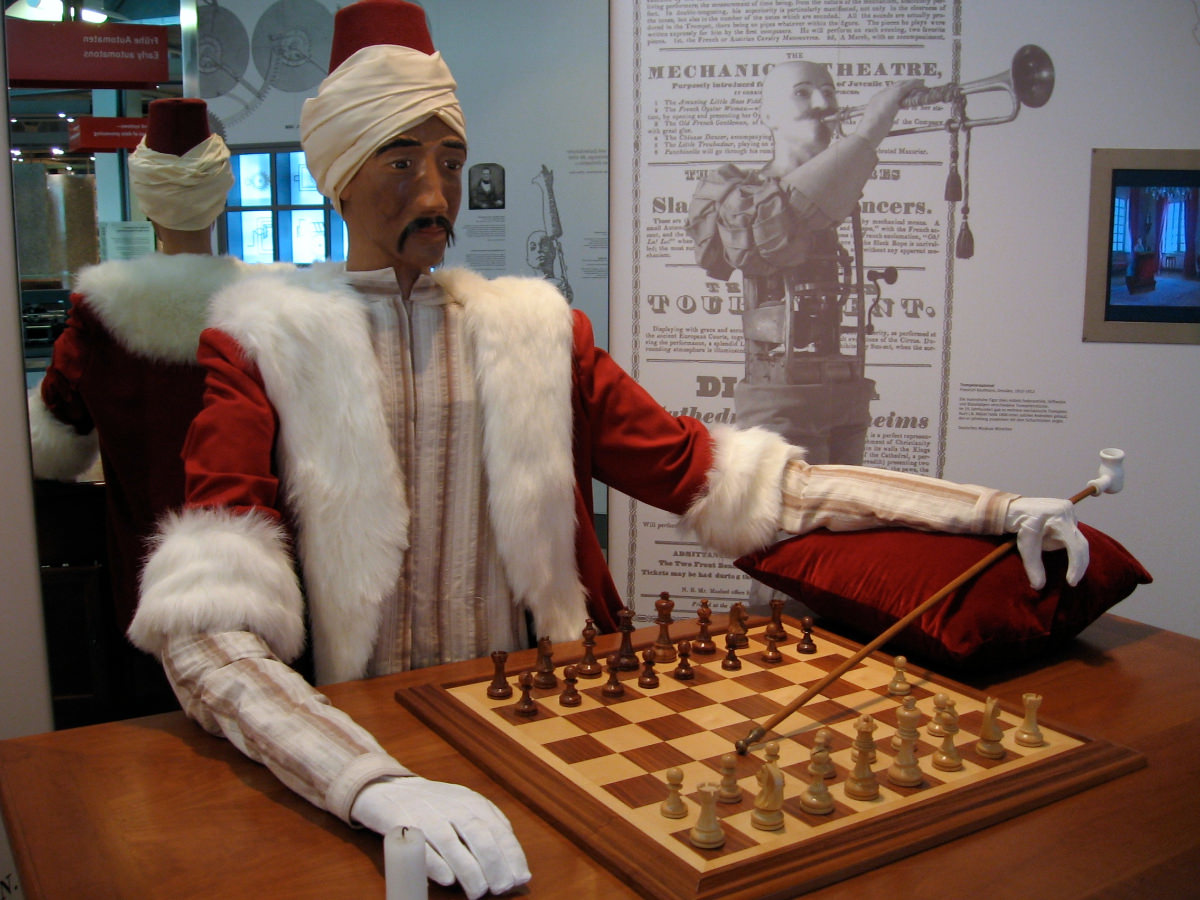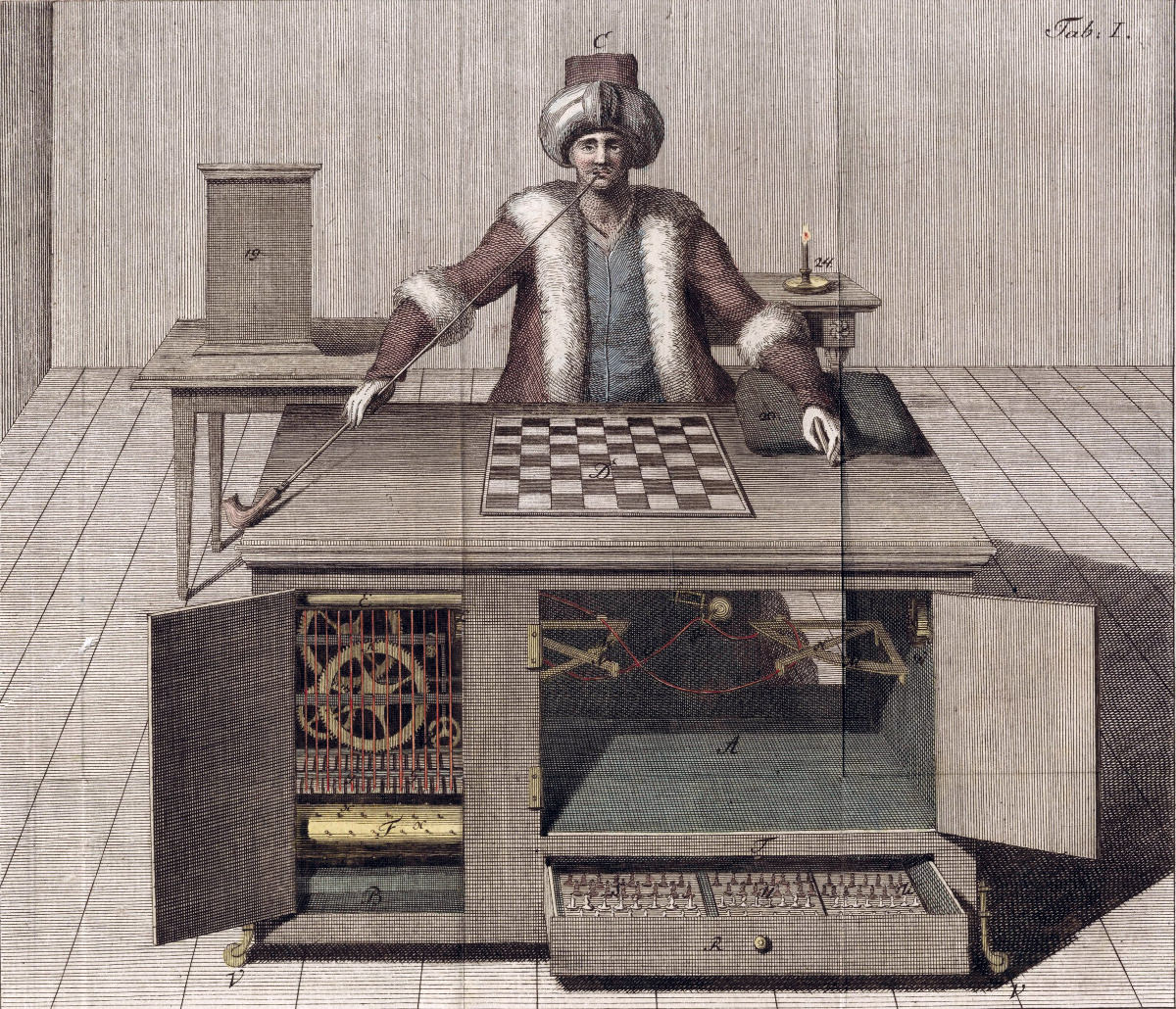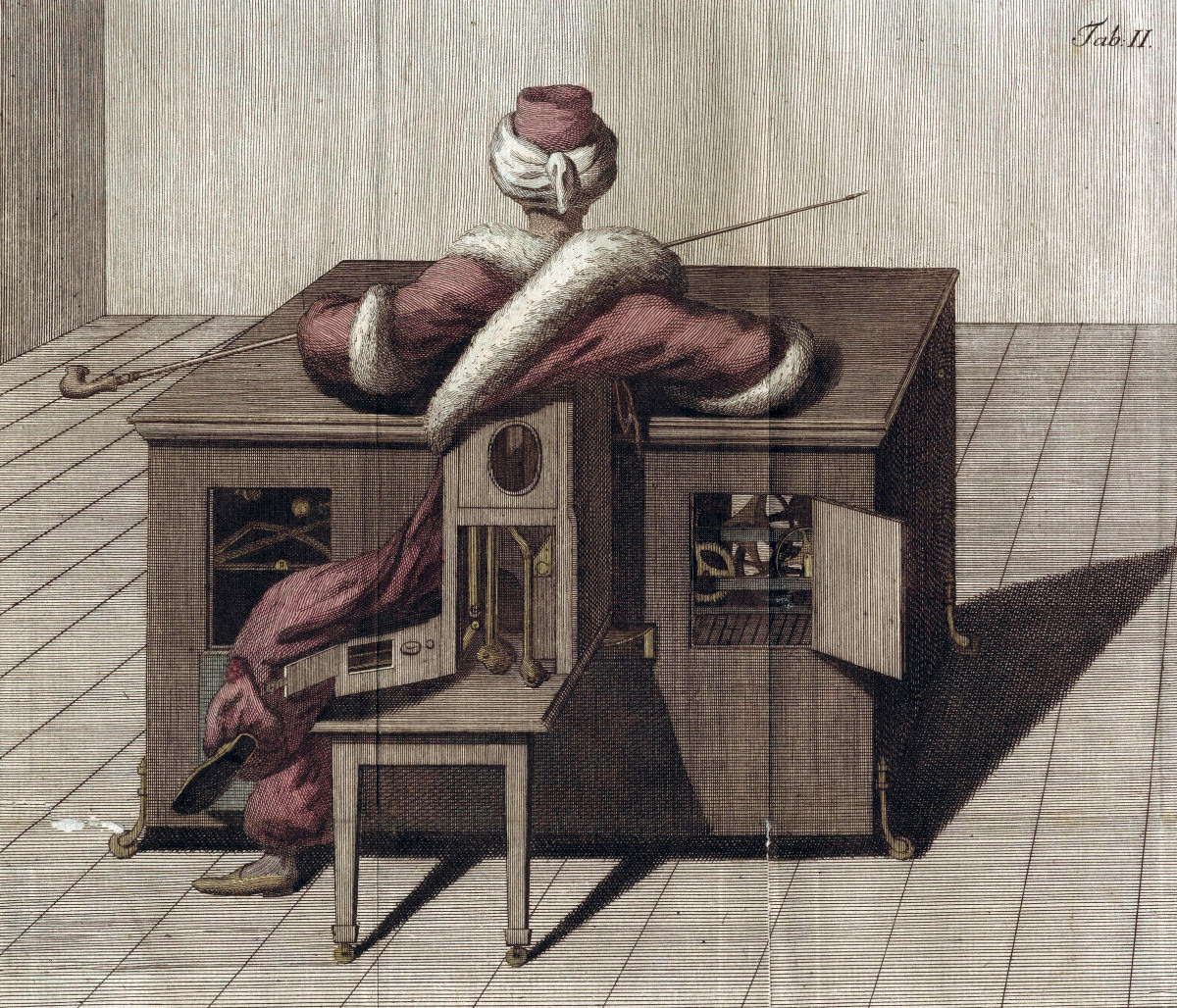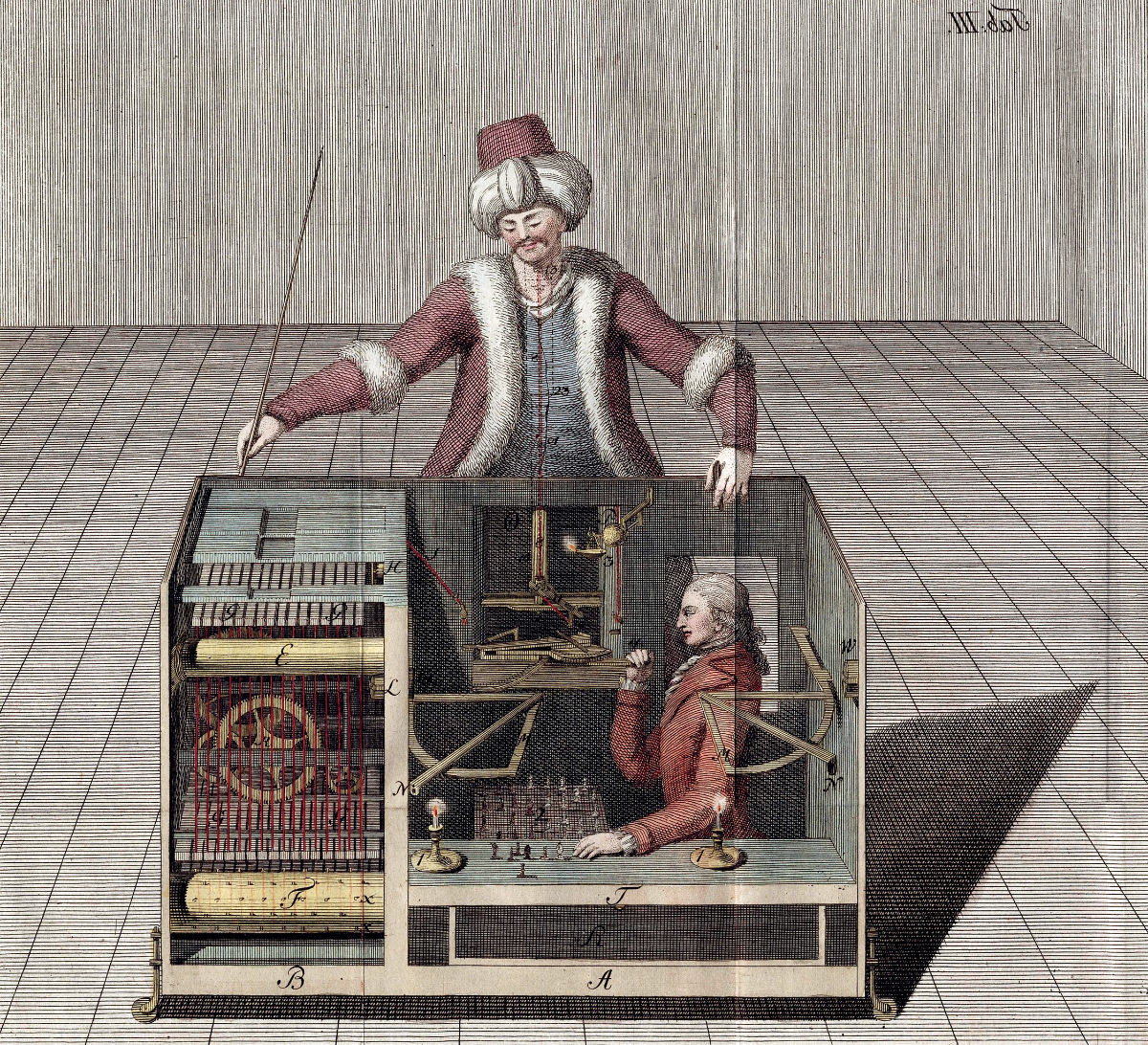The Mechanical Turk, or simply “The Turk,” was an extraordinary machine constructed in 1770 that left spectators in awe as it appeared to play a challenging game of chess against human opponents. What many didn’t know at the time was that this seemingly incredible automaton was a cleverly constructed hoax.

Design of The Mechanical Turk
The design of The Turk was a masterpiece of engineering and artistry. The wooden cabinet stood approximately three feet and seven inches in length, two feet in width, and two and a half feet in height. On top of the cabinet sat a life-size wooden figure dressed in Turkish attire, complete with a turban and a smoking pipe.
Inside the cabinet, there were a series of gears, levers, and clockwork mechanisms visible through glass windows. These were meant to give the illusion of a fully mechanical operation, but they were, in fact, non-functional. The real magic of The Turk lay hidden beneath a false bottom.
A sliding seat allowed a human operator to sit comfortably inside the cabinet. A series of magnets, strings, and intricate mechanical controls enabled the hidden operator to follow the game on the board above and control the mechanical arm of the Turk. The arm was articulated, capable of moving in all directions, and even had an articulated hand to grasp the chess pieces.
Invention of The Turk
Wolfgang von Kempelen, a Hungarian inventor and engineer, constructed The Turk in 1770. Kempelen was an accomplished individual with various inventions to his name, but The Turk would become his most famous creation.
The Turk was initially created as a temporary exhibition to entertain Empress Maria Theresa of Austria and her court. Kempelen’s showmanship and the machine’s apparent abilities so impressed the empress that she requested further exhibitions. What began as a temporary amusement turned into a lifelong project for Kempelen.
How The Turk Worked
The Turk’s operation depended on a human chess master hidden inside the cabinet. The operator would sit on a sliding seat that could be moved from one end of the cabinet to the other, allowing Kempelen to open various doors and display the inner workings without revealing the hidden person.

A cross-section of the Turk from Racknitz, showing how he thought the operator sat inside as he played his opponent. Racknitz was wrong both about the position of the operator and the dimensions of the automaton.
The operator inside would follow the game through a series of magnets and a pantograph mechanism that allowed them to see the positions of the chess pieces on the board above. The operator would then move the Turk’s arm using levers and control rods, giving the illusion that the machine itself was playing the game.
A speaking tube allowed communication between Kempelen and the operator. The sounds of the machinery were also used to mask any noise that might reveal the presence of a human inside.

One of the key challenges was finding skilled chess players who could fit inside the compact space and operate the machinery. Many famous chess players of the time secretly operated The Turk, contributing to its reputation as a formidable chess opponent.
The intricate design, coupled with the skill of the hidden operators, allowed The Turk to tour extensively and defeat some of the most renowned chess players of the time. The illusion was so convincing that many spectators were entirely taken in by the automaton, accepting it as a marvel of mechanical engineering rather than a cleverly constructed illusion.
Napoleon’s Encounter with the Mechanical Turk
One of the most famous anecdotes connected with the Mechanical Turk involves none other than the French Emperor Napoleon Bonaparte. During an exhibition in 1809, Napoleon was intrigued by the machine and challenged it to a game of chess. The Turk’s concealed operator, displaying remarkable skill, managed to defeat the Emperor.

This encounter not only added to the allure of the Turk but also showcased the technological marvel that people believed the machine to be. The victory over Napoleon became a symbol of the machine’s reputed prowess and contributed to the fascination and mystique that surrounded it for many years.
How The Mechanical Turk Was Expose
For many years, the true workings of The Turk remained a well-guarded secret. While there were skeptics and some even claimed to know the secret, no substantial proof was ever offered to the public during its active exhibitions.
The eventual revelation of The Turk’s secret came not from detection but from disclosure. After the machine was destroyed in a fire in 1854, various articles were published by Silas Mitchell, the son of the final owner John Kearsley Mitchell, which finally revealed the mechanism’s secrets to the public. These detailed expositions provided intricate insights into how the illusion was carried out, confirming the suspicions of some but astonishing many others.
The End of The Mechanical Turk
The Mechanical Turk’s end came on July 5, 1854, when a fire swept through the Chinese Museum in Philadelphia, where it was housed. The blaze consumed the building and destroyed many artifacts, including The Turk. The charred remains were reportedly still recognizable, but the intricate machinery, the lifelike figure, and the artistry of the illusion were lost forever.
Johann Nepomuk Mälzel, who had purchased The Turk and exhibited it extensively, had died a decade earlier, and the machine’s ownership had passed to Dr. John Kearsley Mitchell. After the fire, Dr. Mitchell’s son, Silas, took it upon himself to expose the workings of the machine and ensure its place in history.
Where The Mechanical Turk Is Now
Unfortunately, nothing of the original Turk survived the fire. The detailed drawings, descriptions, and accounts provided by Silas Mitchell and others who studied the machine before its destruction have allowed historians and enthusiasts to understand its workings, but the original artifact was lost.
However, the concept and story of The Mechanical Turk have continued to capture imaginations. Various replicas and models have been constructed by enthusiasts and are displayed in museums or private collections. The legacy of The Turk also lives on in literature, films, and even in the name of Amazon’s Mechanical Turk service, which provides crowdsourced human intelligence to perform tasks that computers currently cannot do.
One notable replica was constructed by John Gaughan, an illusion designer and collector of antique magic apparatus. Gaughan’s replica took five years to build and was completed in 1984. Based on extensive research, it represents a faithful recreation of The Turk and is occasionally demonstrated at exhibitions.


